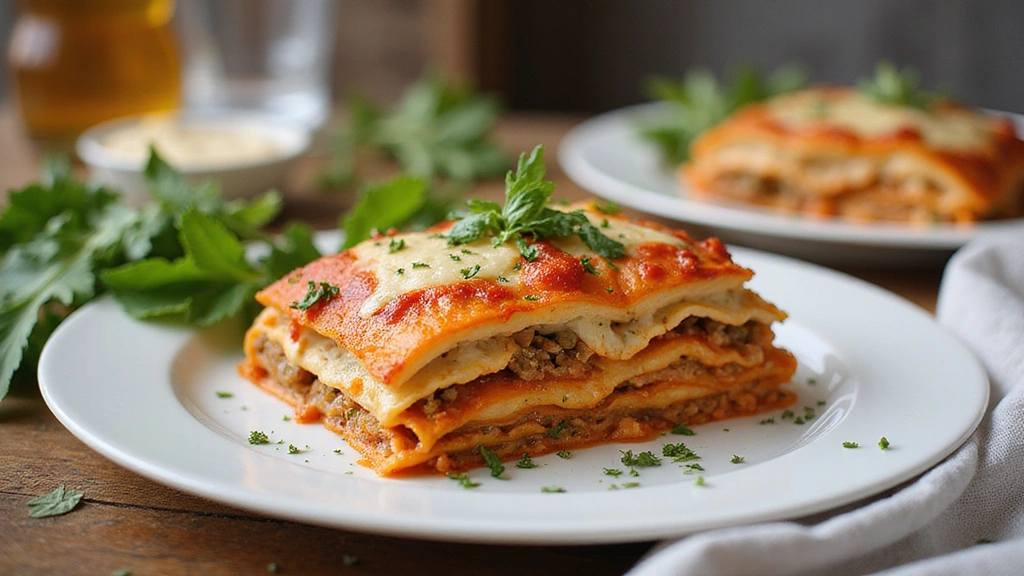Healthy Turkey Lasagna is a delightful variation of the traditional comfort food that combines robust flavors with a health-conscious approach.
The savory blend of lean turkey, nutrient-rich vegetables, and creamy sauces creates a balanced dish that satisfies without the guilt.
I first encountered this recipe during a holiday season, when lighter meals helped balance the indulgences of festive feasts.
It’s become a favorite in my household, where we enjoy it as a cozy family dinner on chilly nights.
Whether you’re new to cooking or a seasoned chef, this recipe is straightforward and rewarding, perfect for impressing guests or simply treating yourself.
The History and Cultural Significance
• Healthy Turkey Lasagna traces its origins to Italy, where it was originally created by Italian cooks seeking a lighter alternative to traditional beef lasagna.
• The dish evolved over decades as dietary preferences shifted, eventually becoming the beloved version we know today with turkey and vegetable enhancements.
• In Italian-American culture, this dish traditionally appears at family gatherings and holiday dinners, symbolizing comfort and togetherness.
• While many variations exist across different regions, the authentic version maintains the rich layering of flavors that sets it apart from imitations.
Recipe Overview
Nutritional Information (per serving)
Essential Equipment Guide
Baking Dish: A sturdy, reliable baking dish is crucial for even cooking and to prevent sticking. Alternatives like glass or ceramic can work, but look for one with good heat distribution.
Chef’s Knife: A sharp, high-quality chef’s knife is essential for prepping vegetables and meat efficiently. A dull knife can lead to uneven cuts, affecting cooking time and texture.
Non-Stick Skillet: Using a non-stick skillet ensures that the turkey cooks evenly without sticking, maintaining its moisture and flavor. Cast iron can be a good substitute if properly seasoned.
Ingredients
For the Base
|
|
| Amount | Ingredient | Notes |
|---|---|---|
| 9 pieces | whole wheat lasagna noodles | cooked al dente |
| 1 pound | lean ground turkey | adds protein |
Vegetables
| Amount | Ingredient | Notes |
|---|---|---|
| 2 cups | spinach | chopped, provides nutrients |
| 1 medium | zucchini | sliced thinly |
| 1 large | onion | diced |
For the Sauce
| Amount | Ingredient | Notes |
|---|---|---|
| 3 cups | tomato sauce | rich flavor base |
| 1 cup | low-fat ricotta cheese | creamy texture |
| 1 egg | beaten, helps bind the cheese |
Seasonings
| Amount | Ingredient | Notes |
|---|---|---|
| 2 teaspoons | Italian seasoning | adds depth |
| 1 teaspoon | salt | enhances flavor |
| 1 teaspoon | black pepper | adds mild heat |
Preparation Methods
Sautéing: Sautéing involves cooking the turkey and vegetables quickly in a skillet over medium-high heat, ensuring even cooking and flavor development. Use a non-stick skillet and keep the ingredients moving to avoid burning.
Layering: Proper layering of the lasagna ingredients ensures even cooking and flavor distribution. Start with a thin layer of sauce, then noodles, followed by turkey and vegetables, repeating the process.
Baking: Baking the assembled lasagna at a consistent temperature allows the flavors to meld together. Ensure the oven is fully preheated and place the dish in the center for even heat distribution.
Step 1: Prepare Ingredients

Gather all ingredients and equipment.
Chop vegetables and set aside.
Cook lasagna noodles according to package instructions.
Drain and lay flat on a towel to prevent sticking.
Step 2: Cook Turkey

Heat a non-stick skillet over medium heat.
Add ground turkey and cook until browned, breaking it apart with a spatula.
Ensure no pink remains and the meat is evenly cooked.
Transfer to a bowl and set aside.
Step 3: Sauté Vegetables

In the same skillet, add onions and zucchini.
Sauté until onions are translucent and zucchini is tender.
Add chopped spinach and stir until wilted.
Remove from heat and combine with cooked turkey.
Step 4: Mix Sauce

In a bowl, combine tomato sauce, ricotta cheese, and beaten egg.
Stir until smooth and well combined.
Season with Italian seasoning, salt, and pepper.
Set aside for layering.
Step 5: Assemble Lasagna

Preheat oven to 375°F (190°C).
Spread a thin layer of sauce mixture over the bottom of a baking dish.
Place a layer of cooked noodles over the sauce.
Top with turkey mixture and repeat layers, finishing with sauce.
Step 6: Bake Lasagna

Cover the baking dish with foil.
Place in preheated oven and bake for 30 minutes.
Remove foil and bake for an additional 15 minutes.
Look for bubbling edges and a golden top.
Step 7: Rest and Serve

Remove lasagna from oven and let it rest for 10 minutes.
This allows the layers to set and flavors to meld.
Cut into squares and serve warm.
Garnish with fresh basil for presentation.
Critical Timing and Temperature Guide
Sautéing Vegetables: Cook over medium-high heat for 5-7 minutes. Look for tender zucchini and translucent onions. Avoid overcooking to prevent mushiness.
Baking Lasagna: Bake at 375°F (190°C) for 45 minutes total. Ensure the oven is fully preheated for even cooking. Avoid opening the oven frequently to maintain temperature.
Resting Period: Allow lasagna to rest for 10 minutes after baking. This helps the layers set and makes serving easier.
Pro Tips for Healthy Turkey Lasagna
• Ingredient Selection: Choose fresh, organic vegetables and high-quality tomato sauce for the best flavor impact.
• Preparation Secret: Let cooked noodles cool on a towel to prevent sticking and tearing during assembly.
• Temperature Management: Ensure all ingredients are at room temperature before assembly to promote even baking.
• Texture Enhancement: Use ricotta cheese with a beaten egg to achieve a creamy, cohesive texture.
• Flavor Layering: Add a pinch of nutmeg to the ricotta for a subtle depth of flavor.
• Make-Ahead Strategies: Prepare the sauce and turkey mixture a day in advance and store in airtight containers in the fridge.
• Restaurant-Quality Finishing Touches: Garnish with fresh basil and a drizzle of olive oil before serving.
• Equipment Optimization: Use a high-quality baking dish for even heat distribution and easy cleanup.
Troubleshooting Common Issues
• Texture Too Dense: Caused by overcooking the noodles or not allowing the lasagna to rest. Recognize it by a gummy texture. Fix by adjusting cooking time and resting properly.
• Flavors Unbalanced: Often due to insufficient seasoning. Taste the sauce and adjust spices before assembly.
• Cheese Not Melting: Occurs when using low-fat cheese. Use a mix of low-fat and regular cheese for better melting.
• Watery Lasagna: Caused by excess moisture from vegetables. Sauté vegetables properly to reduce liquid before layering.
• Undercooked Center: Results from uneven layering. Ensure consistent noodle and filling layers for even cooking.
Variations and Regional Differences
• Southern Italian Variation: Uses ricotta and mozzarella with a richer tomato sauce and includes eggplant slices.
• Vegetarian Style: Replaces turkey with mushrooms and eggplant, and adds extra layers of zucchini for heartiness.
• Mexican Twist: Incorporates spices like cumin and chili powder in the turkey and uses pepper jack cheese.
• Gluten-Free Version: Uses gluten-free lasagna noodles and ensures all sauces and seasonings are gluten-free.
Food Science Behind the Recipe
• Maillard Reaction: This browning process occurs during baking, enhancing flavor and color. Understanding it helps achieve a golden top.
• Protein Denaturation: Cooking turkey causes proteins to denature, changing texture and flavor. Proper cooking ensures tenderness.
• Emulsification: Combining ricotta and egg creates a stable emulsion, providing a creamy consistency that binds layers.
Frequently Asked Questions
What's the most common mistake people make when preparing Healthy Turkey Lasagna? Overcooking the noodles, leading to a mushy texture. Prevent this by cooking them al dente and cooling properly.
Can I freeze the lasagna? Yes, assemble the lasagna and cover tightly before freezing. Thaw in the fridge overnight before baking.
How can I add more flavor? Use freshly grated Parmesan and incorporate herbs like basil and oregano in layers.
What's the best way to reheat leftovers? Reheat in a covered baking dish at 350°F (175°C) for 20 minutes or until heated through.
Can I substitute another meat for turkey? Yes, ground chicken works well as a substitute, offering a similar flavor profile.
How do I prevent the top from burning? Cover with foil for the first 30 minutes of baking to protect the top.
What wine pairs well with this dish? A light red wine like Pinot Noir complements the flavors beautifully.
Serving and Presentation Guide
• Traditional Presentation: Serve in the baking dish with a spatula, allowing guests to experience the layered presentation on their plates.
• Individual Portions: Cut into squares and serve each on a separate plate, garnished with a sprig of basil.
• Family Style: Place the baking dish in the center of the table, encouraging guests to serve themselves.
• Gourmet Plating: Serve on a white plate with a drizzle of balsamic glaze and a sprinkle of Parmesan for a restaurant feel.
Conclusion
Embark on a culinary adventure with this Healthy Turkey Lasagna, bringing together wholesome ingredients in a delicious symphony of flavors.
Whether you're cooking for family or friends, this recipe is a surefire way to impress with its balance of taste and nutrition.
I invite you to try this recipe and experience the joy of a comforting meal made with love and care.

